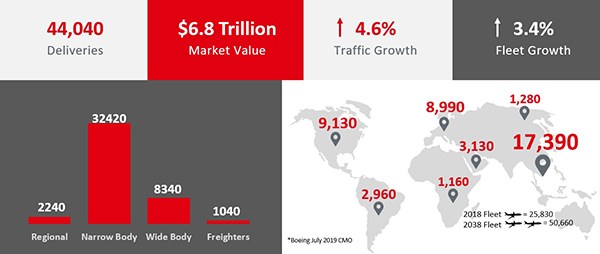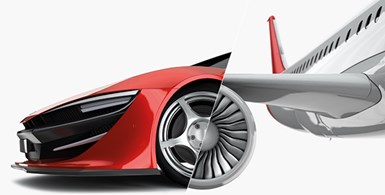Lightweight Potting Compounds Provide Enhanced Mechanical Strength
Sponsored ContentThe next generation of aircraft manufacturing has arrived, and with it the demand for high-performance, sustainable and efficient materials. Newly developed potting compounds are among the lightweight solutions that are significantly improving aerospace manufacturing processes.
Share
Read Next

The aerospace industry has been experiencing a period of strong growth. The latest generation of efficient aircraft have helped reduce fares, allowed more non-stops and new city pairs, and enabled the creation of new airline business models such as Low Cost Carriers, Ultra Low Cost Carriers and even Long Haul Low Cost Carriers. Efficient aircrafts, a healthy economy, and a growing middle class, particularly in emerging markets such as China and India, are fueling the global demand for air travel.

Aviation projections predict a significant increase in fleet over the next 20 years, from 25,830 in 2018 to 50,660 in 2038. (Boeing July 2019 CMO)
To meet passenger demand, the world’s commercial airline fleet is expected to double over the next 20 years. Per Boeing’s July 2019 Market Outlook, nearly 43,000 new aircraft will be required over the next 20 years to meet growth needs and for the replacement of aging aircraft. Aircraft OEM’s are increasing product rates of their most popular narrow body aircraft to record levels.
To achieve higher production rates, they are looking to their supply chain partners to help optimize processes and materials. From a materials perspective, manufacturers are looking for innovations in the areas of:
- Lightweighting – composites, thermoplastics
- Materials capable of being used in automated processes
- Sustainable, environmentally friendly, REACh complaint chemistries
- Faster and easier to process adhesives – fast curing, out of autoclave capable
- Multi-substrate bonding capability
Reducing the weight of the aircraft improves fuel efficiency and can also enable an airline to carry more revenue generating passengers and cargo. Aircraft OEM’s are increasing the amount of advanced composite materials, thermoplastics and aluminum alloys used in the manufacture of aircraft to reduce weight and achieve more efficient aircraft designs. These advanced materials create opportunities for structural adhesives and surface treatments with a broad range of capabilities and advanced performance requirements.
Whether from a performance or regulatory perspective, there is an increased demand for sourcing more efficient materials, such as potting solutions.

Aerospace Potting Solutions
As a leading global manufacturer of adhesives, Henkel offers a broad range of potting, edge fill and encapsulating compounds for use with a variety of substrates, operating temperatures and other environmental factors. Henkel’s aerospace portfolio provides manufacturers with honeycomb core potting and edge sealing requirements, a range of products that meet critical performance criteria and that are easy to apply and easy to store.
Solutions include:
- Low Density
- Lightweight with good compressive Strength
- Intermediate Density
- High compressive strength at temperatures up to 350°F, making these products perfect for potting and panel edge reinforcing
- Variable Density
- These syntactic film products expand using a unique closed-cell process, making them ideal for core fill and stabilization
- Fire Retardant
- Flame Retardant-toughened epoxy paste materials with excellent mechanical strength for edge filling and structural interior potting applications
Overall Potting Benefits Include:

Where added reinforcement, and particularly compression strength, is needed potting compounds are used to fill the voids within the honeycomb and to seal the edges.
Performance
- Lightweight
- High compressive strength at elevated temperature
- Improved mechanical strength
- Fire retardant options available
Efficiency
- Reduced rework due to minimized microcracking and cell wall separation
- Automatable – robotic dispensing possible for paste materials
- Machinable/Drillable – materials can be machined and drilled after full cure
Specification
- Approved to major OEM specifications
Sustainability
- Non-halogenated FR, FST option
- Environmental, Health and Safety (EHS), REACh compliant
Support
- Global product availability
- Superior global technical support and assistance
Strengthening the Core
To reduce weight, honeycomb panel structures are used between thin outer wall layers of various substrates, to provide needed rigidity and strength. These honeycomb sandwich panels are used throughout the aircraft, in primary, secondary and interior structures. Where added reinforcement, and particularly compression strength is needed, potting compounds are used to fill the voids within the honeycomb and to seal the edges.

Applications for aerospace potting compounds.
Henkel potting compounds are available in a broad range of chemistries that enable their use with different substrates, over a range of operating temperatures, and to provide maximum performance under different environmental conditions. Formulations are available that cure at room temperature, are co-curable with the sandwich assembly, and dual cure or step cure capable. Potting compounds are available in both one and two component systems, from low to medium density, and in syntactic formulations.
Henkel LOCTITE® Syntactic materials provide structural performance with a lower density by mixing hollow or gas filled micro-balloons into the epoxy base material. Syntactic materials are available in both paste and film form, and in expanding and non-expanding formulations.
1. Low Density: Lightweight with good compressive strength.
2. Intermediate Density: High compressive strength at temperatures up to 350°F make these products perfect for potting and panel edge reinforcing.
3. Variable Density: These syntactic films expand using a unique closed-cell process, making it ideal for core fill and stabilization.
Changing the Game for Interior Potting

Materials used in aircraft interiors are typically required to meet more stringent health and safety requirements. Cabin materials must not expose passengers to potentially hazardous substances during routine fight, and particularly in the event of fire, must be flame retardant, and not release toxic smoke or fumes when exposed to fire or high heat.
The latest generation of interior potting compounds and adhesives are flame retardant (FR) and meet regulatory requirements for flame, smoke density and toxicity (FST), without the use of halogenated resins and other additives that have been found to be potentially hazardous.
Interior potting applications include reinforcement of floor panels, galley and lavatory assemblies, storage compartments and overhead bins.
Flame Retardant and Resistant Products
The Next Generation of Potting Compounds: Automation
The aerospace industry is increasing the amount of automation within their manufacturing and assembly processes. Automation is being used to increase throughput, improve quality and decrease cost.
Aerospace companies continue to leverage learning from other manufacturing industries, particularly the automotive industry, where automation has enabled high volume, cost efficient production. In addition to reducing labor cost, the use of robotics and dispensing systems improves safety by reducing employee exposure to the adhesives and potting compound chemistries. Consistent, measured material dispensing insures proper mixing, accurate adhesive placement or potting fill, and reduces waste.

Close-up look at robotically dispensed honeycomb core fill material.
New materials, including pastes, potting compounds and films, have been developed to insure suitability for use in automated application systems. For potting compounds, this includes a focus on rheology, including flow and tack for insertion into the core cell without entrapping air or causing voids. Additionally, for more efficient dispensing and application, heat may be required, so the kinetics and stability of the materials at elevated dispensing temperatures becomes increasingly important, particularly for one-component systems.
Henkel, who has global expertise in supporting the automated process of the automotive industry, is well positioned to provide the same level of support and product application knowledge into the aerospace manufacturing environment. View the footage below of automated application tests Henkel is currently conducting with their potting materials.
A New Approach to Sustainability
Sustainability encompasses both the use of more environmentally friendly chemistries and materials, as well as next generation products that operate more efficiently.

In addition to the desire to be a good earth citizen, some sustainability improvements are being driven by Government regulation, such as REACH in the EU. The goal of REACh, and similar initiatives, is to protect human health and the environment by managing the risks or eliminating the use of chemicals deemed hazardous. Within the aerospace industry, a large focus is on the development of chrome free corrosion protection and primers, and the elimination of phenolics and halogenated chemistries.
From a product perspective, the aircraft engine manufacturers continue to improve engine design and functionality to improve fuel efficiency and to reduce emissions. These improved engines operate at higher temperatures to attain efficiency and emissions goals. Adhesives and resin materials used in the engine and nacelle need to perform in this high temperature environment. Improved surface treatment and parts cleaning products are also needed for both OEM and maintenance, repair and overhaul (MRO) activities.
Leveraging Automotive Capabilities
Henkel can leverage its expertise in adhesive technology within other industries including bus, rail and automotive to offer a portfolio of material suitable for aerospace applications, including aircraft interior products.

Henkel has a wide range of solutions developed for other industry segments, with potential for aerospace application. From the automotive business, hotmelts, water-based adhesives, acoustics and noise, vibration and harshness technologies may be options for aerospace applications. Where these products aren’t a direct fit, they create baselines that enable an aerospace specific solution in these areas to be developed much faster. These and other technologies can be used to support aerospace customer needs.
Potting Benefits
Potting compounds improve mechanical strength and provide insulation and resistance to vibration and shock. They prevent corrosion from moisture, thermal cycling, dust, and chemicals. Their properties make them well suited for use in aerospace applications.
To learn more about Henkel’s portfolio of potting solutions, click here, or complete this form to be contacted by a Henkel representative.









